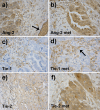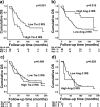High expression of Tie-2 predicts poor prognosis in primary high grade serous ovarian cancer
- PMID: 33151982
- PMCID: PMC7644024
- DOI: 10.1371/journal.pone.0241484
High expression of Tie-2 predicts poor prognosis in primary high grade serous ovarian cancer
Abstract
Background: Antiangiogenic therapy, although part of standard treatment in ovarian cancer, has variable efficacy. Furthermore, little is known about the prognostic biomarkers and factors influencing angiogenesis in cancer tissue. We evaluated the expression of angiopoietin-2 and two endothelial tyrosine kinase receptors, Tie-1 and Tie-2, and assessed their value in the prediction of survival in patients with malignant epithelial ovarian cancer. We also compared the expression of these factors between primary high grade serous tumors and their distant metastasis.
Materials and methods: We evaluated 86 women with primary epithelial ovarian cancer. Matched distal omental metastasis were investigated in 18.6% cases (N = 16). The expression levels of angiogenic factors were evaluated by immunohistochemistry in 306 specimens and by qRT-PCR in 111 samples.
Results: A high epithelial expression level of Tie-2 is a significant prognostic factor in primary high grade serous ovarian cancer. It predicted significantly shorter overall survival both in univariate (p<0.001) and multivariate survival analyses (p = 0.022). Low angiopoietin-2 expression levels in primary ovarian tumors were significantly associated with shorter overall survival (p = 0.015) in the univariate survival analysis. A low expression of angiopoietin-2 was also significantly related to high grade tumors, size of residual tumor after primary surgery and the recurrence of cancer (p = 0.008; p = 0.012; p = 0.018) in the whole study population. The expression of angiopoietin-2 and Tie-2 was stronger in distal omental metastasis than in primary high grade serous tumors in matched-pair analysis (p = 0.001; p = 0.002).
Conclusions: The angiogenic factor, angiopoietin-2, and its receptor Tie-2 seem to be significant prognostic factors in primary epithelial ovarian cancer. Their expression levels are also increased in metastatic lesions in comparison with primary tumors.
Conflict of interest statement
The authors have declared that no competing interests exist.
Figures



Similar articles
-
Expression profiles of VEGF-A, VEGF-D and VEGFR1 are higher in distant metastases than in matched primary high grade epithelial ovarian cancer.BMC Cancer. 2019 Jun 14;19(1):584. doi: 10.1186/s12885-019-5757-3. BMC Cancer. 2019. PMID: 31200683 Free PMC article.
-
The NER-related gene GTF2H5 predicts survival in high-grade serous ovarian cancer patients.J Gynecol Oncol. 2016 Jan;27(1):e7. doi: 10.3802/jgo.2016.27.e7. Epub 2015 Nov 27. J Gynecol Oncol. 2016. PMID: 26463438 Free PMC article.
-
Prognostic impact of HER3 based on protein and mRNA expression in high-grade serous ovarian carcinoma.Virchows Arch. 2017 Feb;470(2):143-151. doi: 10.1007/s00428-016-2050-6. Epub 2016 Dec 2. Virchows Arch. 2017. PMID: 27913862
-
HMGA2 and high-grade serous ovarian carcinoma.J Mol Med (Berl). 2013 Oct;91(10):1155-65. doi: 10.1007/s00109-013-1055-8. Epub 2013 May 19. J Mol Med (Berl). 2013. PMID: 23686260 Review.
-
A comprehensive insight into the role of molecular pathways affected by the Angiopoietin and Tie system involved in hematological malignancies' pathogenesis.Pathol Res Pract. 2023 Aug;248:154677. doi: 10.1016/j.prp.2023.154677. Epub 2023 Jul 5. Pathol Res Pract. 2023. PMID: 37467636 Review.
Cited by
-
The role of Angiogenesis and remodeling (AR) associated signature for predicting prognosis and clinical outcome of immunotherapy in pan-cancer.Front Immunol. 2022 Nov 21;13:1033967. doi: 10.3389/fimmu.2022.1033967. eCollection 2022. Front Immunol. 2022. PMID: 36479101 Free PMC article.
-
Angiopoietin-1 Upregulates Cancer Cell Motility in Colorectal Cancer Liver Metastases through Actin-Related Protein 2/3.Cancers (Basel). 2022 May 21;14(10):2540. doi: 10.3390/cancers14102540. Cancers (Basel). 2022. PMID: 35626145 Free PMC article.
-
[Expression of Tyrosine Kinase Receptor 2 in Oral Squamous Cell Carcinoma and the Effect on Cell Proliferation and Migration and Epithelial-Mesenchymal Transition Process].Sichuan Da Xue Xue Bao Yi Xue Ban. 2023 Mar;54(2):342-349. doi: 10.12182/20230360106. Sichuan Da Xue Xue Bao Yi Xue Ban. 2023. PMID: 36949696 Free PMC article. Chinese.
-
Interaction of tumor‑associated macrophages with stromal and immune components in solid tumors: Research progress (Review).Int J Oncol. 2023 Feb;62(2):32. doi: 10.3892/ijo.2023.5480. Epub 2023 Jan 20. Int J Oncol. 2023. PMID: 36660926 Free PMC article. Review.
-
Research Progress in Prognostic Factors and Biomarkers of Ovarian Cancer.J Cancer. 2021 May 13;12(13):3976-3996. doi: 10.7150/jca.47695. eCollection 2021. J Cancer. 2021. PMID: 34093804 Free PMC article. Review.
References
-
- Coxon A, Bready J, Min H, Kaufman S, Leal J, Yu D, et al. Context-Dependent Role of Angiopoietin-1 Inhibition in the Suppression of Angiogenesis and Tumor Growth: Implications for AMG 386, an Angiopoietin-1/2-Neutralizing Peptibody. Molecular cancer therapeutics. 2010;9: 2641–2651. 10.1158/1535-7163.MCT-10-0213 - DOI - PMC - PubMed
Publication types
MeSH terms
Substances
LinkOut - more resources
Full Text Sources
Medical
Miscellaneous

